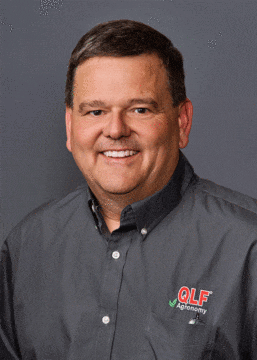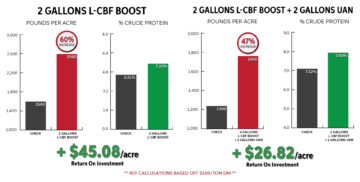Brian Knapp; QLF Agronomy RSA Southern Iowa, Eastern Kansas, Missouri
For generations, in the Flint Hills of Kansas and areas to the south and west, where native warm-season grasses dominate the range, traditional fertilizer programs have failed to yield a return on investment. Native warm-season grasses offer higher energy but lower protein levels compared to cool-season grasses. Enhancing both quantity and protein levels of forage represents significant potential earnings for cattle producers. In these regions, sustaining a cow-calf pair during the grazing season requires a minimum of 7 acres. Consequently, investing in traditional soil fertility programs has not proven economically viable for improving forage quantity or crude protein levels.
In the spring of 2023, QLF Agronomy conducted a trial in the Flint Hills of Kansas, renowned for its native rangelands. The aim of the 2023 trial was to enhance dry matter pounds per acre by a minimum of 500 pounds at a cost of less than $20 per acre. It was determined that increasing forage quantity by 500 pounds per acre could potentially allow for doubling stocking rates to 3.5 acres per cow-calf pair, as opposed to the traditional 7 acres per pair. The primary challenge in enhancing native range production lies in extremely low available nutrient levels, to the extent that applied nitrogen fails to elicit a response. Previous multi-year research endeavors had demonstrated that employing the QLF Liquid-Carbon Based Fertilizer (L-CBF) approach enhances nutrient availability in the soil. The trial successfully achieved its objective, surpassing 500 pounds of dry matter increase with higher protein levels at costs of $8 and $13 per acre.
The trial comprised 5 different treatments utilizing various products or combinations of products. Among these, the two treatments exhibiting the most promising results and highest ROI demonstrated an increase in dry matter (DM) production by 600# and 980# respectively, along with an enhancement in crude protein levels, as depicted in the graph.
Understanding plant physiology and soil biology sheds light on the mechanisms facilitating this improvement. Firstly, the applications were carried out a couple of weeks after the green-up of the forage, allowing for a foliar-type application. The molasses-based QLF Liquid-Carbon Based Fertilizer, when applied foliar, functions much like providing a small child with a bottle of Mountain Dew – it ignites the photosynthetic processes within the plant, leading to enhanced plant performance and health.
Secondly, the native biology in the soil proliferates due to being supplied with adequate amounts of high-quality cane molasses present in the QLF Liquid-Carbon Based Fertilizers. This, in turn, results in better mineralization of nutrients. By combining improved photosynthesis and enhanced nutrient mineralization, plants are primed to exhibit heightened performance, thereby contributing to a more favorable bottom line for the operation.
Improving plant performance and health translates to enhanced animal health and production, contributing to farming success.


